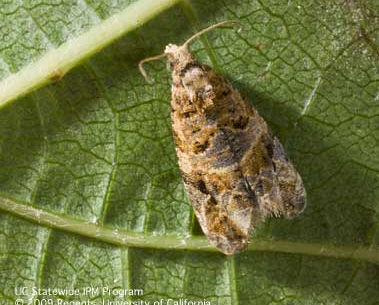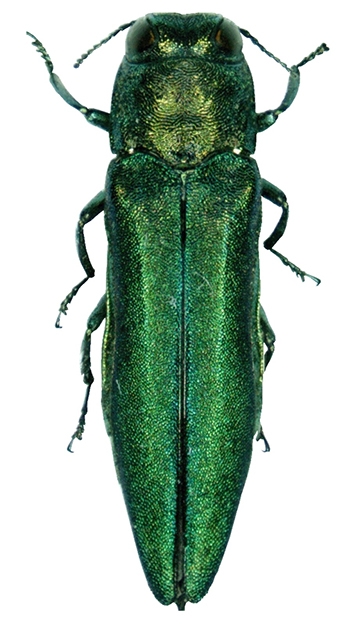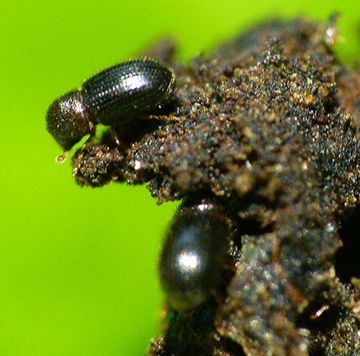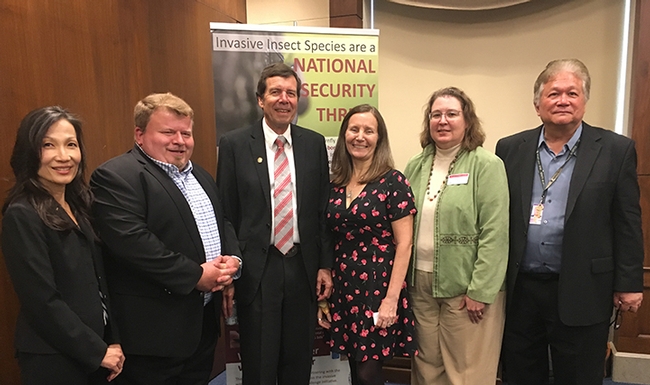
Those catchy words headlined a recent notice of a congressional briefing.
What does coffee, wine and baseball bats have to do with integrated pest management (IPM), you ask?
Well, insects can wreak havoc on the coffee, wine and forestry industries. Consider these invasive species:
- the coffee berry borer, native to Africa, is a pest impacting the coffee industry
- the European grapevine moth, native to southern Italy, targets grapevines
- the emerald ash borer, native to Eastern Russia, Northern China, Japan, and Korea, is a forestry pest.
So there you have it: coffee, wine and baseball bats.
IPM specialist Frank Zalom, distinguished professor, UC Davis Department of Entomology and Nematology and a past president of the Entomological Society of America, played a key role in that U.S. Congressional briefing, held last month in the Rayburn House Office Building.

A newly authored bill by Rep. Tulsi Gabbard (D-Hawaii) and Rep. Ted Yoho (R-Florida) seeks a broader expansion of AIPM and a broader invasive species policy. The bill, the Areawide Integrated Pest Management (AIPM) Act of 2018 (H.R. 5411), would amend the Agricultural Research, Extension and Education Reform Act of 1998 with respect to enabling competitive grants for certain areawide integrated pest management projects, and for other purposes.
Zalom moderated the panel and delivered a presentation on the history of AIPM and the need to manage some pests on an areawide basis. AIPM is particularly useful for sites that are not suitable for management on an individual basis, such as natural and urban areas or for public health pests. It is similar to IPM, Zalom said, in that its focus is on implementing systems-based strategies that utilize multiple tactics which emphasize prevention, avoidance, monitoring, and suppression using practices that are biologically-based and reduce risk to human health and the environment. However, its focus is on managing pest populations in all the habitats in which they occur. It involves multi-year strategic planning and organization, and it tends to utilize technologies that may be difficult or less effective when used on a limited scale.

First found in Napa County in 2009, the moth was eventually detected in nine California counties. A partnership that included the United States Department of Agriculture (USDA), California Department of Food and Agriculture, County Agricultural Commissioner Offices, grape growers, and University of California Cooperative Extension Advisers and specialists implemented an applied research and public outreach and engagement program that ultimately resulted in the elimination of the insect from throughout these grape-growing areas. (For its work, the European Grapevine Moth Team, led by Lucia Varela, UC IPM advisor, won a Distinguished Service Team award in 2016 from UC Agriculture and Natural Resources, and received an international award at this year's 9th International IPM Symposium.)
Note that Rep. Gabbard, in particular, wants to protect Hawaii's coffee industry from the recently introduced coffee berry borer, and Rep. Yoho, the U.S. citrus industry from the Asian citrus psyllid and the devastating bacterial disease that it vectors.
Partner host organizations included the ESA, Weed Science Society of America and the Association of Public and Land-Grant Universities (APLU).
Four panelists—Faith Oi of the University of Florida, Lee Van Wychen of the Weed Science Society of America, Paula Shrewsbury of the University of Maryland and Kelley Tilmon of Ohio State University--zeroed in on urban pests, aquatic pests, forestry pests, and agricultural pests, respectively, and the industry impacts.
- Oi elaborated on mosquitoes, including the yellow fever mosquito, Aedes aegypti, a major public health issue.
- Van Wychen discussed the waterhyacinth, an aquatic pest in the Sacramento/San Joaquin Delta and Everglades in Florida.
- Shrewsbury drew attention to the emerald ash borer, a pest in both urban and rural forests
- Tilmon covered the agricultural pest, the brown marmorated stink bug.
The panelists focused on various geographic topics to help Congressional offices from across the nation understand why AIPM is relevant to them and to support AIPM-related policies.
AIPM strategies not only offer important economic, health and environmental benefits, Zalom said, but the Food Quality Protection Act of 1996 directs federal agencies to use IPM techniques in carrying out pest management activities.
Coffee, wine and baseball bats? The next time you're enjoying a ball game or sipping a cup of coffee or a glass of wine, think about the emerald ash borer, coffee berry borer and the European gravevine moth.
And the IPM specialists trying to protect us from invasive species...
Attached Images:
